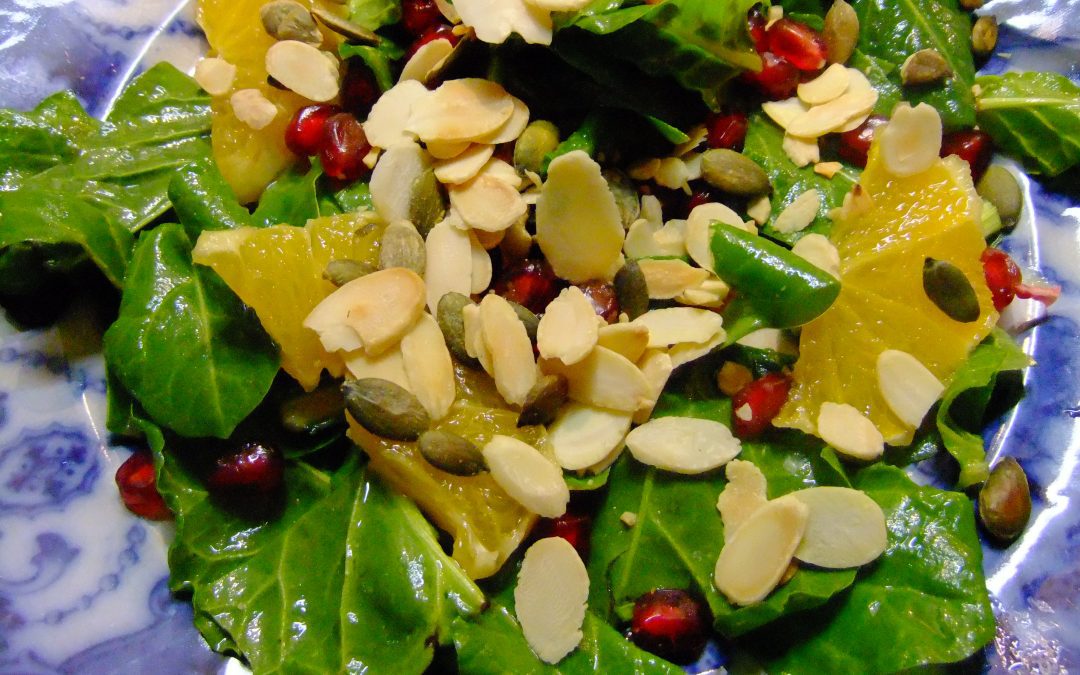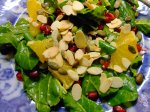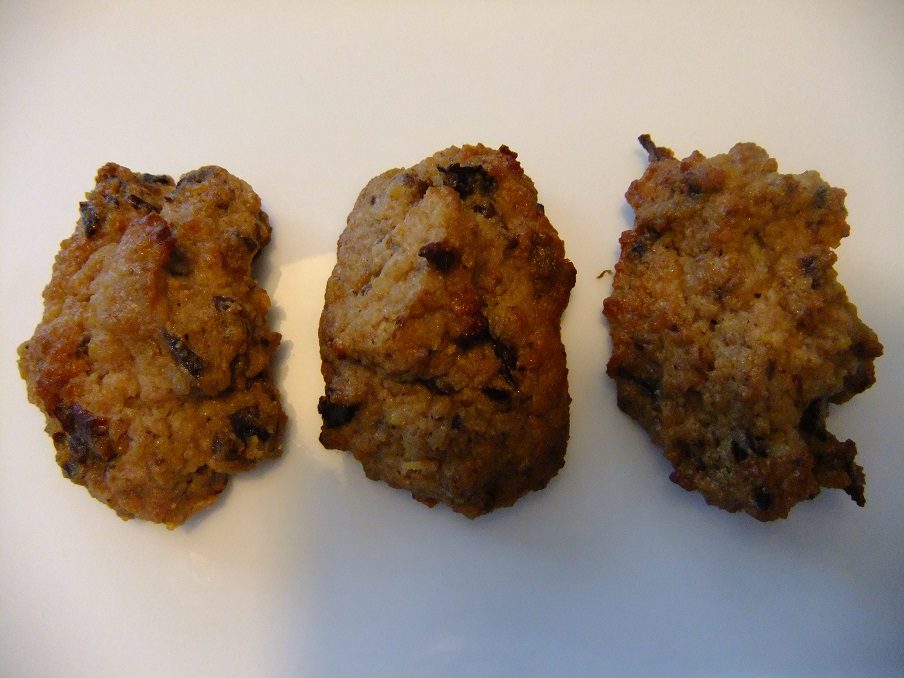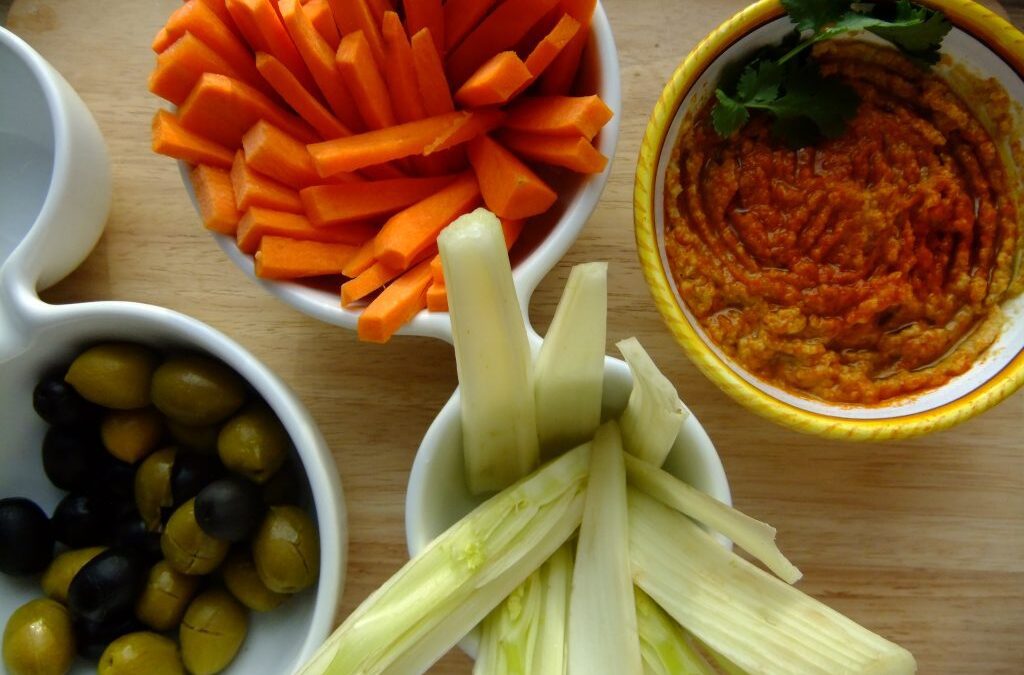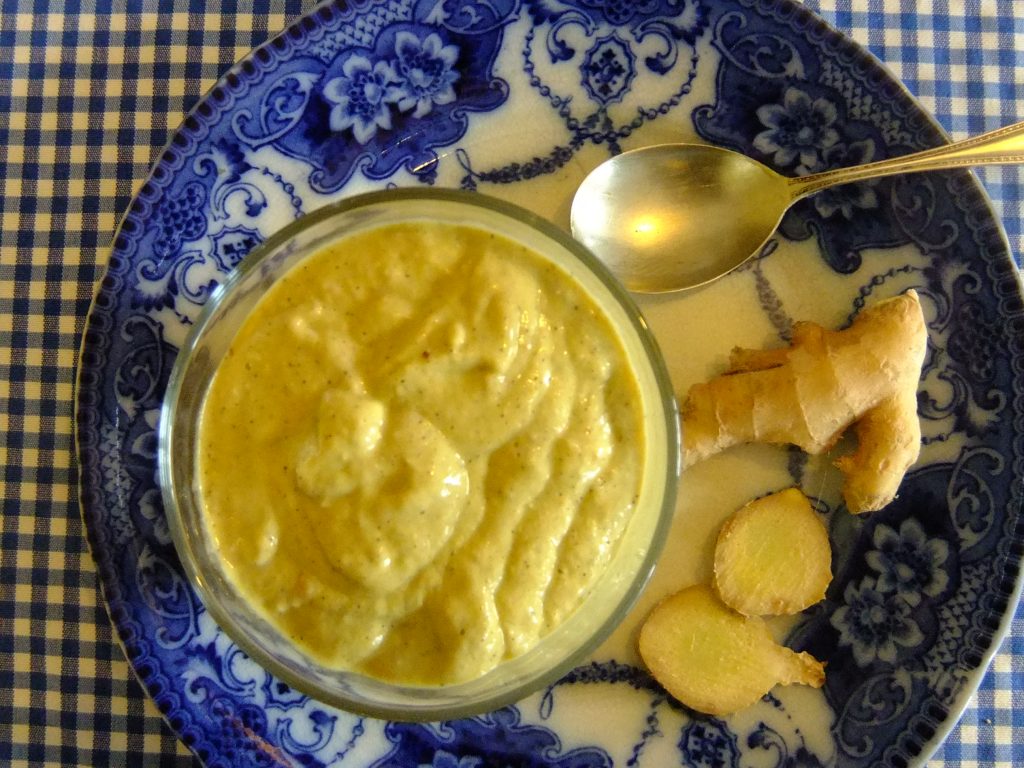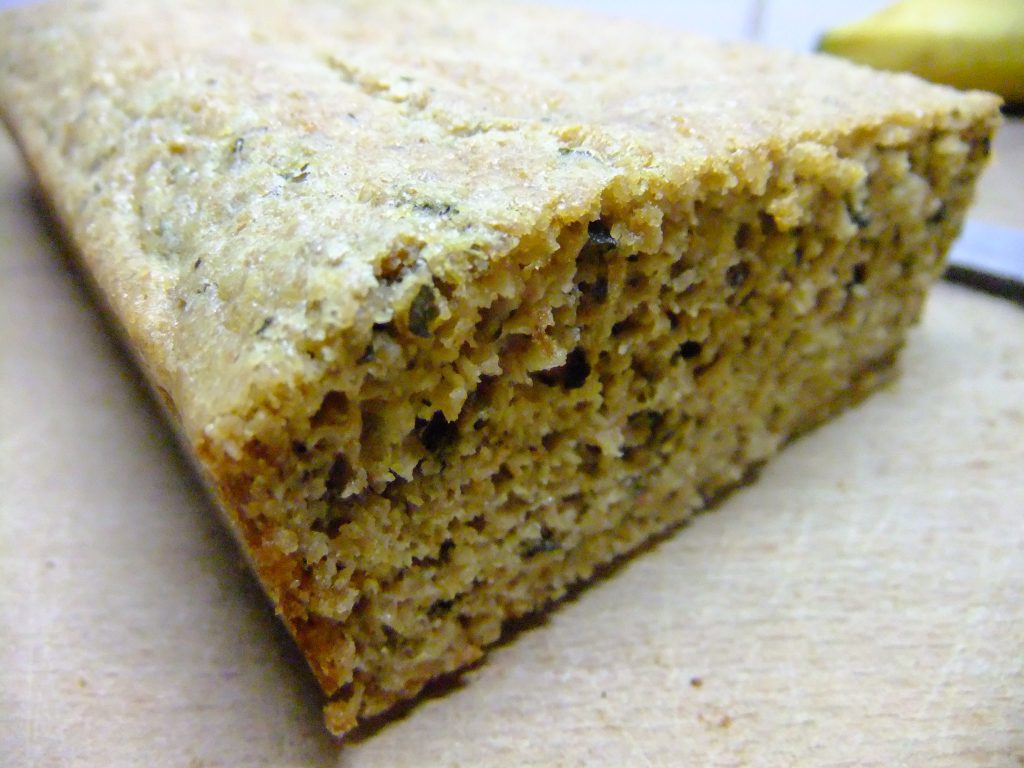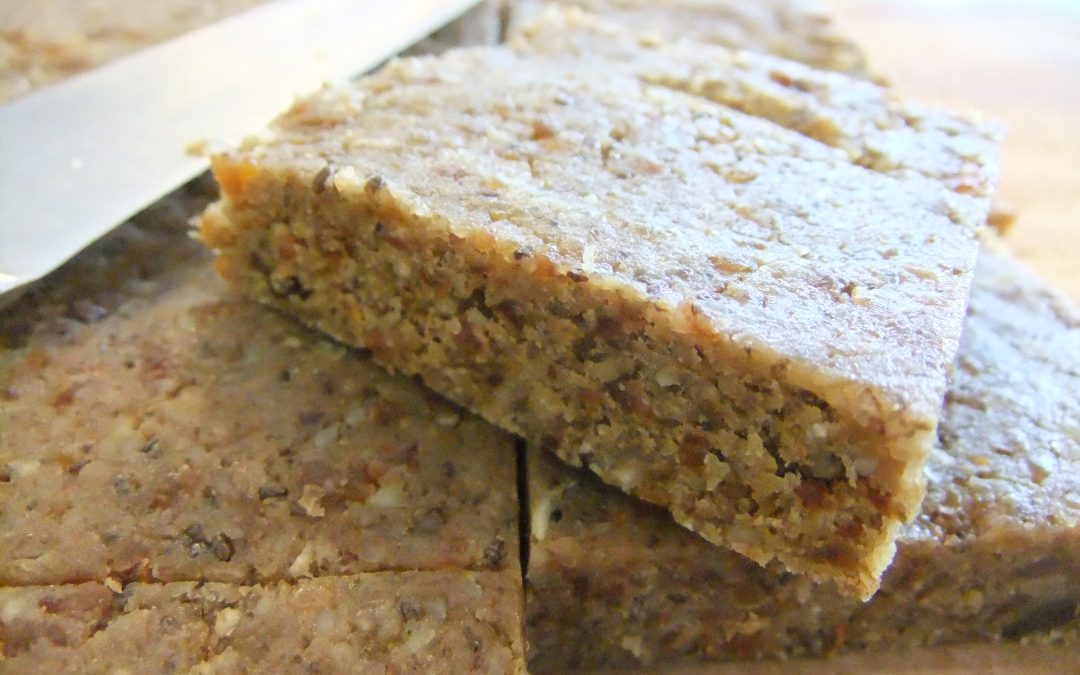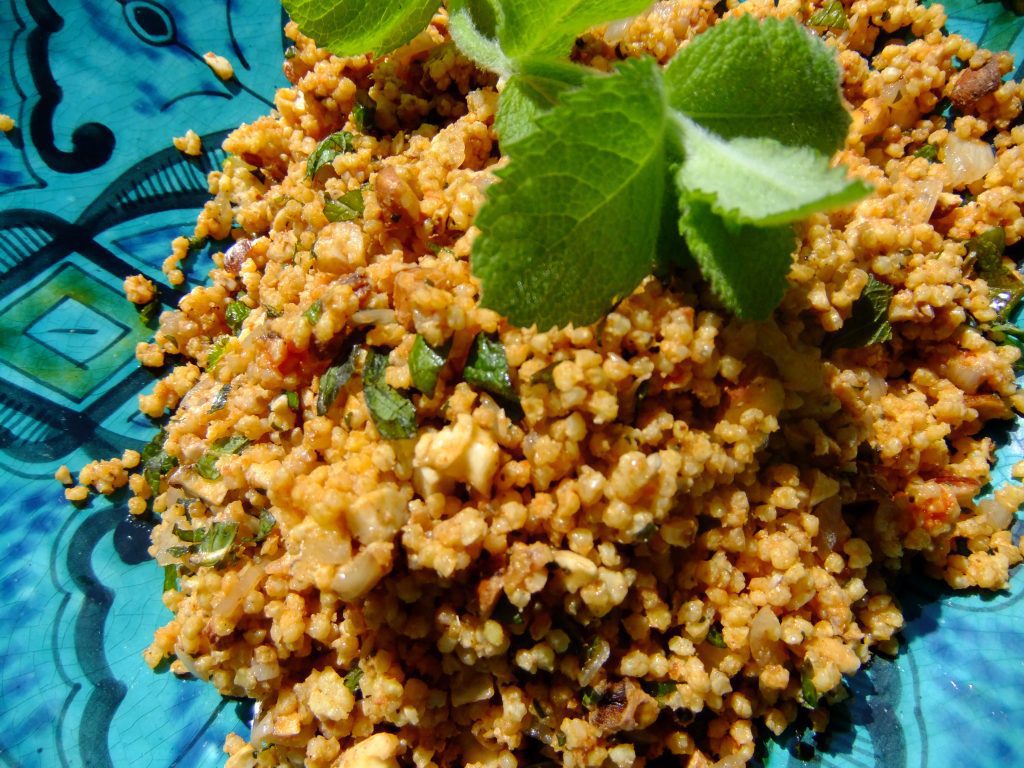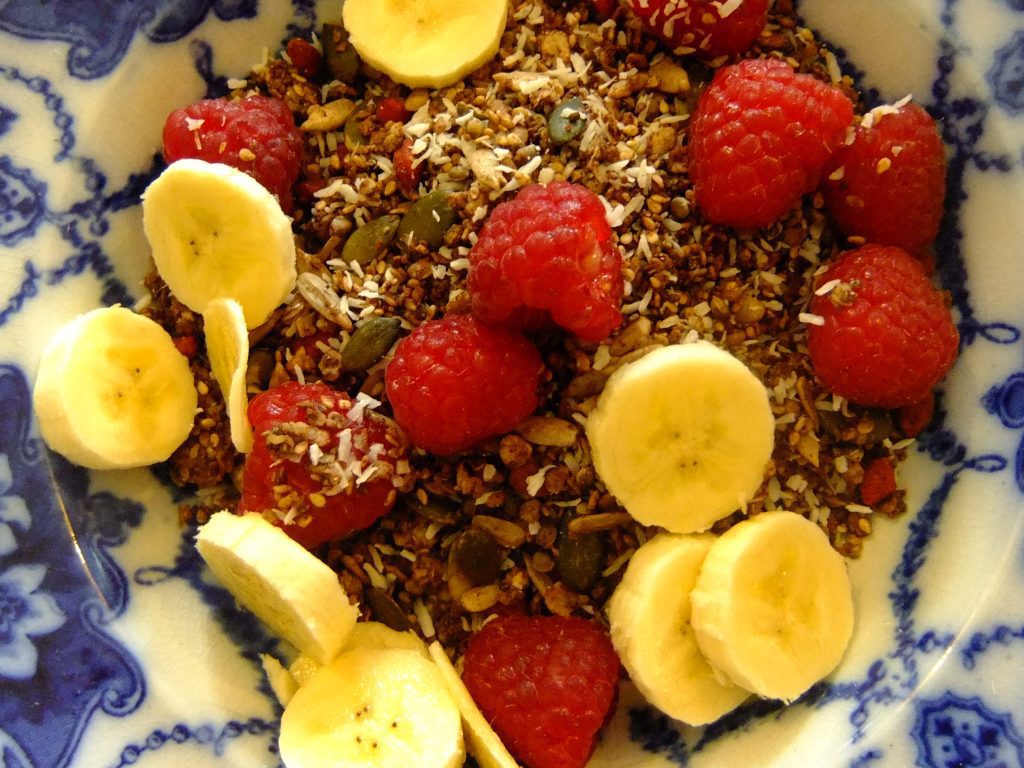
Jan 5, 2017 | Anna's Best Recipes, Sides, starters, soups & snacks

Spinach pomegranate & orange salad
I stole this salad from a newspaper and adapted it to include some protein (flaked almonds) so you’re not just getting a huge blood sugar spike from all the fruit. This makes a lovely starter before a winter stew of some sort. Or else make a big platter of it for a buffet meal. The colours are stunning. Pomegranates are still in season in January (they start in November in Asian shops and good greengrocers). If you can’t get pomegranates then either increase the orange to a whole one or substitute a tablespoon of goji berries soaked overnight in clean water.
2 large handfuls baby spinach, washed and dried
1 tbs pumpkin seeds (for SC diet initial 12 weeks use almonds instead)
1 tbs flaked almonds
1/2 a small orange
A fresh pomegranate (you will use 1/4 to half of the seeds)
Dressing:
3 tbs virgin hazelnut or walnut oil (or use extra v. olive oil at a push)
Juice of 1 small orange
Freshly ground black pepper
Pinch of Himalayan/Atlantic Sea Salt
1. On a very low heat in a heavy bottomed pan, gently dry the pumpkin seeds and flaked almonds, until they seem dry and the pumpkin seeds are slightly swelled. It is better to eat nuts and seeds raw but this light toasting does make them super delicious. Remove from the heat as soon as they are slightly dried and crispy.
2. While this is happening, whack your whole pomegranate all over with a wooden spoon or a pestle for a few minutes. This loosens the seeds. Then cut it in half and pick out the ruby-coloured seeds.
3. Cut your orange in half across its equator, cut off the skin and pith with a sharp knife. Cut the remaining piece in half, then slice as thickly or as thinly as you feel like.
4. Mix your dressing in a screw top jar and shake to amalgamate.
5. Now put half the pomegranate seeds, the orange, spinach, and at least a tablespoon of dressing in a large bowl and toss until coated and glistening.
6. Divide between two plates, adding more pomegranate seeds if you think there’s not enough for your liking. Sprinkle over the almonds and pumpkin seeds. Enjoy…
Why this is good for you:
Spinach, like all dark green leafy veg, is rich in folic acid. Folic acid is important for your liver, helping keep your skin clear and healthy. Its also important for your mental health, helping reduce stress levels. Pomegranates are high in antioxidants and the raw, virgin cold-pressed oils are a good source of omega 6 oils and vitamin E for beautiful skin. Don’t forget to keep your virgin nut/seed oils in a cool dark place in an airtight bottle, so the delicate beneficial oils don’t get damaged. Pumpkin seeds are a rich source of methionine (and zinc) which helps clear heavy metals and other toxins from the body. Almonds are high in calcium and magnesium for good stress management and clear skin.

Nov 17, 2015 | Anna's Best Recipes, Cakes, biscuits & bars
I love to make these around Christmas-time. They are deliciously moist, flattish but light and are a crowd-pleaser. Prune-haters also usually like these cakes, provided you keep it a secret that they contain prunes! They will keep in an airtight jar in a cool place for about 10 days. I love spices so I generally also add some extra. I add a generous pinch of ground cloves and ground ginger but you don’t have to.
Makes 16 small cakes about 1cm high
60ml water
85g ground almonds
1/2 level teaspoon mixed spice
1 egg white, stiffly beaten
175g pear, peeled
50g dried stoned prunes (with no sulphur dioxide additive), preferably organic, finely chopped
1. Put prunes and water in a small pan and simmer till water is absorbed
2. Combine with the almonds and mixed spice
3. Grate the pear into the almond mixture and stir
4. Fold in the egg white to make a thick paste
5. Place 16 dessertspoonfuls of mix on a greased baking tray
6. Bake 170C (or 155C fan) for 20 mins or until lightly browned
Why these are better for you
First of all these cakes have some high quality protein from the almonds and egg white. This means that the sugars from the pears and prunes only gradually hits your bloodstream (protein slows down absorption of sugars in your gut). This is good news if you like to keep your energy, mood and blood sugar levels fairly even. Sulphur dioxide is a preservative that can have unpleasant effects on your digestive system. Mixed spice, like all spices, contains antioxidants that help reduce inflammation and slow the ageing process. Cooking damages foods, so these are not as healthy as eating raw food (e.g. my raw green tea macaroons on this blog). But sometimes you just want cake anyway…

Apr 30, 2015 | Anna's Best Recipes, Dressings, rubs, spreads, sauces & more, Sides, starters, soups & snacks

Middle Eastern tahini dip with crudites
This is based on a Sophie Grigson recipe I loved, but lost. My husband says this version is the best of my attempts to recreate it. It’s dead simple. Enjoy with strips of red pepper, carrot, cucumber or celery and maybe a few olives. Dips with veg sticks before a main course are a great way of encouraging your kids to eat veggies too – take advantage of them being hungry!!
For a smoother dip use normal tahini made from roasted sesame seeds. For a coarser (and even more vitality boosting) dip use raw tahini (e.g. Carly’s) from health shops. Raw seeds retain their beneficial oils to do your body even more good. If you’re not going to use this dip within half an hour or so, store in a small screwtop glass jar or else a small glass/ceramic container with clingfilm over the top (but not in contact with the dip itself) to stop it drying out.
To make this dip into a sauce add a little more water to thin and drizzle over cooked white fish or felafels.
To serve 3-4 as a starter
2 cloves garlic
2 level tbs dark tahini
1 1/2 tbs lemon juice
1 dsp extra virgin olive oil
1 level tsp cumin
Pinch Himalayan or Atlantic sea salt
Pinch cayenne pepper
4 tbs water
Mini food processor method:
1. Crush the garlic and throw it and the rest of the ingredients into a mini food processor.
2. Blend for a couple of minutes, scraping down the sides of the processor a few times to get everything well mixed.
3. If you have time, allow to sit for half an hour for the flavours to amalgamate.
Traditional method:
1. Crush the garlic and place in a mixing bowl with everything except the water.
2. Mix well with a wooden spoon, then add half the water. The tahini will become quite stiff at this point, just keep mixing and it will start to relax and absorb the water.
3. Mix well, then add the rest of the water and work till smooth. This will be a more rustic mix than using the food processor. If you have time, allow to sit for half an hour for the flavours to amalgamate.
NB. If you are on a ketogenic eating plan, avoid eating more than 1/2 cup raw carrots in the day. Like all root veg, they are rich in sugar and too many will derail your programme.
Why this is good for you:
Garlic is a fantastic booster for your whole body. It kills yeast infections and overgrowths of pathogenic (“bad”) bacteria in your gut. This is good news if you want to sort out your digestion or achieve beautiful skin. Garlic’s sulphur compounds also support your liver to clear chemicals, used-up hormones and other toxins out of your body. Skin conditions are usually largely due to problems in the digestive system. Sort those out and you have dont more than 90% what you need to do. If you are not used to eating garlic, especially raw garlic, start with a little and gradually build up. Garlic is in my top 10 vitality boosting foods. Spices like cumin and cayenne pepper also have great benefits – anti inflammatory, anti-ageing and more. Have you had your spices today?

Apr 16, 2015 | Anna's Best Recipes, Breakfasts & smoothies
This breakfast is delicious but even more importantly is packed with anti-inflammatory, immune-supporting goodness that keeps you full for hours. It’s fresh and zingy but really filling. If you like your smoothie thinner, add more liquid. If you prefer it thicker add less liquid and eat from the glass with a spoon like I do – yum!
It also has protein which your body needs in order to make antibodies to ward off infections. See below for more details of how this smoothie helps your immune system.
For 1 hungry adult:
1 scoop/2 rounded dsp of Sun Warrior Warrior Blend protein powder or other protein powder of your choice (e.g. pea protein, sprouted rice protein, or for for a dairy option, Solgar Whey to Go Vanilla) If you don’t have protein powder, make sure to use more avocado and seeds to keep you fuller longer
200ml unsweetened milk of your choice: almond, hemp, coconut milk, home-made kefir, milk
1 small/medium pear, washed
2.5cm of peeled sliced fresh ginger (slice it across the grain to avoid long fibres in your brekkie!)
1 level tsp ground turmeric (or half a thumb of peeled fresh turmeric, sliced)
Rounded tbs ground seeds e.g. linseed or a blend (e.g. pumpkin, sesame, sunflower and linseed). If you don’t have seeds you could use nuts, either ground or soaked overnight
Optional: 1/4 ripe avocado (use more if you don’t have protein powder)
Optional: a teaspoon of lecithin granules (helps you digest fats and feeds your brain)
Optional (for extra sweetness): pure stevia drops, erythritol or xylitol to taste, or a little honey
1. Remove stalk from the pear, cut up the rest (seeds and all) and throw in the liquidiser.
2. Add the liquid and then other ingredients. Blitz for a minute until smooth. Enjoy.
Why this smoothie is good for you:
Turmeric, ginger and avocados contain the natural anti-inflammatories curcumin, gingerol and vitamin E. So if you want to get rid of annoying skin conditions or boost your digestive wellness these are fantastic things to add to your everyday eating.
Flax seeds and pears contain soluble fibre which feeds the beneficial bacteria that support your resistance to infections both viral and bacvterial. Ginger is anti-viral too. Ginger and turmeric selectively encourage growth of good bugs in your gut.
Because this breakfast is rich in protein, beneficial oils and low in sugars (from fruit) it helps regulate blood sugar to keep your energy, concentration and mood even throughout the morning. Like all meals, this shouldn’t be gulped down – you need to “chew” all your food to mix it with saliva and digest it properly. Avocados are rich in monounsaturated fatty acids and vitamin E, great for moisturising skin and body from within. Yoghurt and kefir provide friendly bacteria important for a healthy digestion, clear skin and stable mood. Fermenting makes the milk easily digested, removing the casein (dairy protein) that triggers food sensitivities in so many people. Lecithin granules help emulsify (digest) fats and are a great source of phospatidyl choline. Pho. choline is only found in egg yolks, lecithin and organ meats and are essential for memory.

Feb 25, 2015 | Anna's Best Recipes, Breads, crackers, pancakes & wraps
This bread is soft and moist and really filling. It’s such a huge treat when you are off grains! Because its high in protein and fibre (unlike normal breads) you don’t need to eat it with extra protein in order to avoid blood sugar dips and energy crashes. Enjoy it with my special buttery spread for bread, with virgin coconut oil or organic butter (or clarified butter for dairy intolerant people). If you want to increase your energy levels, use the coconut oil as a spread instead of butter (unlike butter, the MCT fraction of coconut oil – about 50% – goes straight into energy production)
Dry ingredients:
100g milled flax seeds. Flax is another name for linseed.
20g ground almonds
½ level tsp Atlantic sea salt or Himalayan salt (NOT ordinary table salt which contains harmful additives)
1 level tsp bicarbonate of soda (also called bread soda)
Plus, if you have it, one of the following
2 tsp dried oregano and 1 level tsp of paprika
1 level tsp Ceylon cinnamon and/or ½ level tsp cardamom
1/2 tsp each ground cumin and coriander
Finely grated rind of organic lemon
Wet ingredients:
2 eggs
1/3 cup (approx. 80ml) water, home made dairy kefir or non-dairy kefir*
1/3 cup extra virgin olive oil
1. Turn on the oven to 150C (or 140C for fan)
2. Mix together all the dry ingredients. In a separate larger bowl whisk or beat together the wet ingredients.
3. Add the dry ingredients to the wet and mix together well.
4. Line a 1lb/450g loaf tin (around 15 x 94 x 74cm) with greased parchment or greaseproof paper, pour in the mix and bake for 50-60 mins.
[If you only have a 2lb loaf tin (around 23 x 13 x 7cm) you can still use it but reduce the baking time to around 40 minutes. The resulting loaf will be half the normal height].
5. The loaf is done when a needle or knife inserted into the thickest part of the bread comes out clean. Remove from oven, remove paper and cool on a wire rack. Refrigerate if you intend keeping it for more than 1-2 days.
Variation
For a deliciously moist courgette flax loaf reduce the amount of kefir/water to 50ml and add 1 medium courgette, finely grated, to the dry ingredients.
*In my tags for this recipe I say this bread is dairy-free, so how come kefir is allowed, when its usually made from milk? This is because, if you make your own kefir properly at home, the problematic milk protein (casein) and lactose (milk sugar) have been broken down by the fermentation process. Kefir “grains” hydrolyse (break down) casein, and digest lactose, turning it into lactic acid. Good news all round, if you are recovering form dairy intolerance. Kefir also contains over 20 different types of beneficial bacteria to help heal digestive issues. Unsweetened non-dairy kefir can be a good option for shop-bought.
Why this is better for you
You may wonder why I mention kefir in a “dairy-free recipe”. Kefir is tolerated by people with dairy intolerance because provided it is properly made (at home) it contains no lactose and no casein. Lactose is the milk sugar that’s problematic in lactose intolerance. Most yoghurts still contain lactose because they are not properly (fully) fermented. Yoghurt you make at home will not contain lactose. Casein is the milk protein that dairy intolerant people react to. Kefir grains “hydrolyse” (digest) casein, leaving you able to eat kefir but not yoghurt, cheese, milk which all still contain casein. This loaf avoids grains completely so its really low in carbohydrates. If you are gluten intolerant or want to follow low GI, ketogenic, stoneage or paleo eating plana, it fits right in. Research shows that if you want to maintain good skin, digestion and keep mentally sharp then low grain low carbohydrate way of eating is really important for you. Flaxseeds are a really rich source of soluble fibre, which feeds good bacteria in your gut which helps your skin, your digestion, and even your brain function!! I would recommend having this bread now and again, rather then every day. This is because heating reduces the levels of beneficial oils in the ground flaxseeds. All nuts and seeds have more benefits when you eat them raw or soaked, rather then cooked. It’s still a million times better than sliced pan though!

Sep 10, 2014 | Anna's Best Recipes, Breakfasts & smoothies

Blackberry & avocado thickie or smoothie
Just concocted this for breakfast today. I had lots of foraged blackberries in the freezer and had taken out a cupful to thaw overnight. I have to say it was fab, and SOOO SIMPLE. I make mine so thick I eat it with a spoon, but you can also make it thinner with more liquid. This will keep you full for ages with its generous amounts of healthy protein, good fats and only small amounts of carbohydrate (sugars). It’s also a genius way of incorporating the fermented superfood, keffir, into your diet. Blueberries or mixed frozen berries also work fine instead of the blackberries. For the ground seeds, I grind organic seeds, keeping them fresh in a glass screw top jar in the fridge. It’s best this way but you can of course buy a good cold-milled ready-made brand like Linwood’s and store airtight in the fridge.
What you need (for one person):
1. Liquid:
200ml liquid + extra to thin: additive-free almond/coconut milk with no added sugar. (If you eat gluten, you can use unsweetened oat milk instead if you like and if you eat dairy you can use kefir or cow/goat milk)
2. Protein and good-for-you fats:
One scoop high quality protein powder – my favourites are Sunwarrior Warrior Blend Vanilla and Solgar Whey to Go vanilla (which contains dairy). You could also use sprouted rice protein, hemp protein or pea protein or a mixture of them to give a more neutral flavour.
1 tbs ground seed blend – pumpkin, flax, sesame and sunflower
Optional: 1/4-½ a ripe avocado
3. Antioxidant-rich fruits:
1 cup fresh or thawed frozen blackberries, blueberries or mixed berries.
4. Optional sweetening if needed:
If you use Sun Warrior protein powders they usually contain stevia so you don’t need extra sweetening.
Stevia drops/powder or, if you don’t have it, Xylitol to taste
To make:
Blitz everything together for a minute or two. If you like a thinner drink, add more liquid. Enjoy…
Why this is great for you
Berries are a great source of bioflavonoids, naturally occorring plant substances that help build and maintain collagen in your skin, bones and connective tissue. This means firmer, younger looking skin and stronger bones. Berries also contain salicylates. Salicylates are substances related to aspirin, that also have an anti-inflammatory effect. Making this a thick breakfast that you eat with a spoon means you will eat it more slowly, allowing the food to mix with the digestive enzymes produced in your mouth. This allows you to digest it even better than simply knocking back a thinner drink in 5 seconds.
Avocados are a good source of monounsaturated fats and vitamin E, both of which are good for your heart and skin health. Vitamin E helps dampen down allergies and inflammation (eg hives, eczema). Vitamin E is also important to help vitamin C be used in your body. This again helps build collagen, bones and keep your blood flowing properly to all areas of your body. Vitamin E moisturises your skin from within. If your skin is healthy you will never need to use moisturisers except maybe on your feet, where slight natural hardening of the skin protects your feet. Ground seeds and lecithin produce essential fats for better skin, hair and general health. Non genetically-modified (non GMO) lecithin provides phosphatidyl choline, crucial for cognitive function. Phosphatidyl choline is found in organ meats and organic egg yolks. So if you don’t often eat those foods, lecithin is really important. Good quality protein and good fats are important to eat at breakfast and every meal. Low protein, high grain diets are the main cause of weight gain, diabetes and cognitive/mental health issues as well as digestive issues and skin problems. For more information, read “Grain Brain” by David Perlmutter.

Aug 29, 2014 | Anna's Best Recipes, Desserts & drinks
This super-simple dessert used carob powder to give a lovely, chocolatey flavour. Carob is a tropical pod that contains a sweet, edible pulp and inedible seeds. After drying, the pulp is roasted and ground into a powder. It has a flavour a bit similar to chocolate. The sugars in cashew nuts, bananas and carob make this dessert very sweet. You will get the smoothest texture if you grind the cashew nuts very finely on their own in a coffee/spice grinder before adding to the other ingredients but its still lovely if you don’t bother. I never do. the recipe is from “Cooking without” by Barbara Cousins.
For 4
115g/1 cup raw cashew nuts
15ml/1 tbsp carob powder (health stores and gourmet shops), sifted
140ml filtered water or unsweetened additive-free non-dairy milk (e.g. almond, hemp milk, coconut)
2 large bananas
1 tbsp flaked almonds
1. Blitz everything in a small food processor for 2 minutes until smooth and creamy.
2. Spoon into 4 ramekins/glasses and refrigerate minimum 20 mins or overnight.
3.Toast flaked almonds lightly on a dry frying pan until very slightly coloured. Just before serving, sprinkle on top of the carob cream.
Variation:
If you are feeling fancy, add a sprig of fresh mint and serve with a side of fresh raspberries.
Why this is better for you:
This dessert is a good, easy to make “treat”. Its not intended to be eaten every day as it has far more natural sugars than you need in a healthy diet. Carob is a great substitute for chocolate. Chocolate contains at least 2 stimulants – caffeine and theobromine. These stimulate your nervous system, which, in turn, increases heart rate and contracts muscles. It’s a lot like the fight-or-flight response. The better quality chocolate (over 70% cocoa and ideally organic) contains some good antioxidants but eating more than a couple of small squares once or twice a week would be loading you up with stimulants – just like drinking coffee does.
Cashew nuts contain some protein and beneficial fats help keep your blood sugar levels (and energy and mood) even. Although bananas are high in sugars and not much else, they do contain fructo-oligosaccharides which can help feed beneficial bacteria in your gut. Beneficial bacteria are needed for mood, clear skin, healthy digestion. They are also important for your immune system to protect against infections, colds and abnormal growths.

Jul 30, 2014 | Anna's Best Recipes, Cakes, biscuits & bars, Sides, starters, soups & snacks
I made these raw protein bars for snacks a few weeks ago, adapted from Christine Bailey’s recipe. I meant to bring the leftovers in to my nutrition clinic to share with colleagues but somehow we just couldn’t bear to part with them. We ate the lot over the following week. These are quite like the Nakd bars you find in health stores. This bar is perfect when you are short of time and need something to support your blood sugar levels and you want something sweet. These are a good emergency breakfast option, post-gym snack or lunchbox treat. These can be frozen in batches for up to a month.
Makes 12 large bars
For unusual ingredients, don’t forget to check out “larder & shopping”
200g/1½ cups raw Brazil nuts
60g gluten-free organic porridge oats or buckwheat flakes
30g ground chia seeds (buy ready-ground or use a coffee/spice grinder)
250g dried unsulphured apricots, soaked overnight in filtered water/250g dried apricots plus 6 tbs water/freshly squeezed orange juice
3 heaped tbs unsweetened or vanilla protein powder (Nua Naturals rice protein, Nuzest Clean Lean Protein or Sunwarrior Classic/Warrior blend are all great. Solgar Whey-to-go vanilla is another option if eat dairy and are using this snack for sports nutrition/muscle recovery.
Zest of 1 orange, organic if possible
Pinch of Himalayan or Atlantic Sea Salt
Essential equipment: food processor
1. Chop the apricots roughly. If you have not already done so, grind the chia seeds and set aside.
2. Place the nuts and oats in a food processor and process until fine. Add the chia, apricots, protein powder and orange zest and process till well mixed. If you have used soaked apricots this will usually form a dough. If your apricots are unsoaked then you will need to start adding the orange juice or water about 2 tbs at a time, pulsing in between, until the mixture forms a dough. The amount of liquid needed will vary depending how dry the apricots are.
3. Press the mixture into a 20cm square tin lined with baking parchment and freeze for at least 1 hour so it firms up enough to cut neatly.
4. When frozen, cut into 12 bars. Store in the fridge or freezer until needed.
Note: It’s important that the chia seeds be ground. This helps the bars stick together really well.
Variations:
- For a gingerbread version, add 1 level tsp each of ground ginger and cinnamon along with the protein powder.
- For a chocolatey version, add 2 heaped teaspoons pure cocoa powder along with the protein powder.
Why these bars are better for you:
Because these bars contain protein from the nuts, seeds and protein powder, they help keep you feeling fuller much longer. The fact that they are raw means more nutrients such as essential omega 3 and 6 oils. Brazil nuts are a rich source of magnesium which helps relax the bowel to prevent constipation. The bars are rich in crucial minerals such as selenium and iron which are important for the thyroid gland, brain function and energy production. Buying unsulphured (brown) apricots in the health store avoids the sulphur dioxide that causes unpleasant digestive symptoms for so many people. Sulphur dioxide is added to many dried fruits as a preservative and is always listed on the packet so its easy to avoid by paying attention to labels.
Christine Bailey is a successful nutritional therapist who published The Functional Nutrition Cookbook in 2012. It contains over 130 tasty recipes that are super-healthy but also delicious.

Jun 25, 2014 | Anna's Best Recipes, Sides, starters, soups & snacks
This is my gluten-free take on a delicious Middle Eastern bulgar wheat salad by Claudia Roden. Instead of wheat, I use millet (naturally gluten-free). Everyone takes seconds when I serve it at a buffet or barbeque. I love having it for leftovers too and it keeps for several days. Serve it with some protein such as roast chicken, a bean salad or some felafels, and a large green salad or some wilted spinach leaves dressed with lemon juice and extra virgin olive oil.
For 6:
330g/1½ mugs whole millet grains (from wholefood stores)
800ml/3 mugs boiling water, filtered if possible
1 large onion, red if possible
3 tbs extra virgin olive oil
110g tomato puree
Juice of 1 lemon
A bunch of fresh mint, or 1 tbs dried
1 rounded tsp ground cumin
1 rounded tsp ground coriander
1 level tsp ground allspice
110g raw walnuts and/or hazelnuts, coarsely chopped
1. Add boiling water and millet to a large saucepan, cover with a lid and simmer on a medium heat until the water has been absorbed completely. Fork it up a little to break up the grains.
2. While the millet is cooking, peel and chop the onion and add to a large bowl with the olive oil, tomato puree, lemon juice, cumin, coriander, allspice, nuts and mint.
3. When the millet is cooked, allow it cool down so its tepid or cold. Then add to the rest of the ingredients and mix gently with a fork, avoiding mashing the grains, which should remain distinct from each other.
4. If you have time, leave this sit for an hour, or even overnight, for the flavours to develop.
Why this is good for you:
Herbs and spices are packed with beneficial antioxidants which prevent food from spoiling. A high intake of spices helps delay aging and is linked to lower incidence of skin conditions such as psoriasis and eczema. Cumin and coriander help soothe and repair the digestive system while mint is anti-spasmodic, helping prevent cramps, gas and spasms in the bowel.

Feb 19, 2014 | Anna's Best Recipes, Breakfasts & smoothies
This granola is adapted from one I found in Patrick Holfords “Food Glorious Food” cookbook, which I love. Because this granola contains lots of good fats it’s really filling so a little goes a long way. For sweetness, stevia/erythritol is preferable to xylitol but any is acceptable. This keeps for a month in an airtight glass jar in a cool dark cupboard. Serve the granola with natural yoghurt, kefir, organic milk or some no-added sugar dairy-free milk (such as additive-free coconut/almond) and some berries or a chopped pear/apple. Yum!
Use this as a breakfast or a (smaller) dessert.
Serves 4-6
1 heaped tbs virgin coconut oil (1 tablespoon = 2 dessertspoons)
150g gluten-free oatflakes, organic if possible (if you can eat gluten, then standard organic porridge/jumbo oatflakes are perfect)
3 level tbs tahini, ideally a raw brand such as Carly’s
3 heaped tbs pumpkin seeds
3 heaped tbs sunflower seeds
3 heaped sesame seeds
3 heaped tbs chopped raw walnuts
3 heaped dessicated coconut
3 heaped tbs goji berries
1 heaped tsp ground cinnamon
1 heaped tsp ground ginger
To sweeten: 2 tbs xylitol, Dr Coys Stevia Erylite (or 30 drops pure liquid 100% stevia) or monk fruit extract from health stores/online
2 dsp cacao/cocoa powder
Optional (if you have issues digesting fats or if you are a post-menopausal woman):
2 heaped dsp GMO-free lecithin granules health stores (sunflower lecithin is better than soy).
To serve:
Milk of your choice and fruit (choose from mixed berries, apple or pear, organic if possible)
Optional 1-2 dsp cold milled flax seeds
Optional protein boost: High-grade pea protein e.g. Nuzest 1-2 dsp
- Gently melt coconut oil in a large wide-bottomed saucepan.
- Add xylitol or stevia, stir for a second, then add tahini. Stir to mix.
- Remove from heat, add oatflakes, mix well, then add everything else, making sure not to heat.
- Taste and if you want, add more stevia/xylitol/Dr Coys Stevia Erylite.
To serve:
Ideally soak overnight in half water half milk of your choice (makes everything easier to digest, more filling, and the goji berries plump and soft)
Top with (if recommended by nutritionist) 1-2 dsp cold-milled flax seeds and mixed berries or a chopped apple or pear (organic if possible)
Why this is good for you
Most granola is mainly grain and sugar/honey and doesn’t contain the raw healthy fats or protein needed for a balanced breakfast that keeps blood sugar stable. This granola has generous protein from nuts and seeds, and also lots of essential fats omega 3 and 6, all of which keep you fuller longer and feed your brain. Virgin coconut oil contains medium chain triglycerides – these are really good for energy production and brain health. Spices like cocoa, ginger and cinnamon are antioxidant and can delay the ageing process AND modify your gut bacteria for better weight management and health. Spices also support your immune system. Lecithin is rich in phosphadityl choline and so great for your brain. Lecithin also breaks down (emulsifies) fats into tiny droplets, helping you digest them. The granules have a lovely, creamy taste. Concerned about eating soya products? Lecithin is free from soya protein. The best lecithin is from sunflower seeds.
For storing this granola, it’s best to use an airtight glass or metal container in the fridge. Polyethylene (PET) or plastic containers with recycling numbers 1,2 and 4 are also safe for food storage. That way, your food won’t be absorbing toxic BPA (bisphenol A). Avoid any polycarbonate containers or those with recycling number 7 – these leech BPA into your food. Avoiding BPA is good news if you want to avoid being overweight or having hormonal imbalances like diabetes, serious breast/prostate disease or energy issues.

